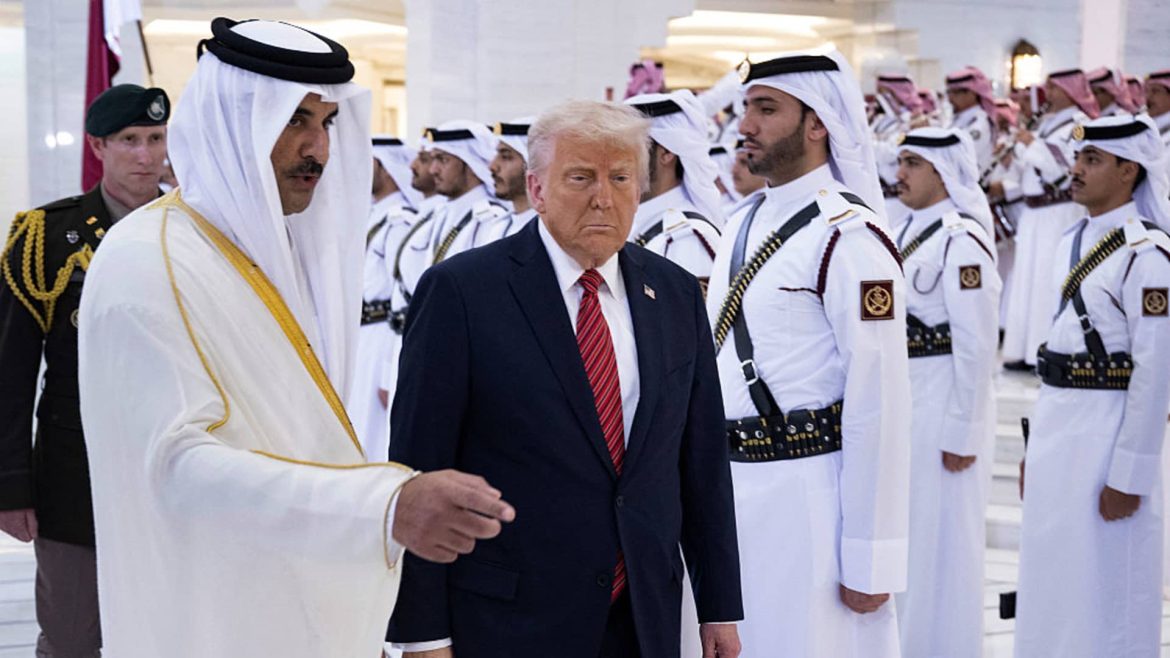The sprawling coverage of Donald Trump’s visit to the Gulf states, particularly Qatar, reveals a fascinating tableau of diplomacy, symbolism, and regional ambition that transcends mere political protocol. It underscores how these Gulf countries harness cultural artifacts, technological showcases, and financial power to craft a narrative of influence, prestige, and strategic alignment, especially during a period of heightened geopolitical and economic stakes.
The Gulf as a Stage for Power and Influence
When examining the myriad headlines and stories, it’s claro that Gulf nations are orchestrating an elaborate preamble to Trump’s visit, blending tradition with modernity to project strength and relevance on the global stage. The deployment of elements such as Cybertrucks, elite camels, luxury jets, and mega-deals demonstrates a layered approach to diplomacy, where symbols convey intent and alliances.
This spectacle is not limited to ostentatious displays but is deeply rooted in regional aspirations. The Gulf states, including Qatar, Saudi Arabia, and the UAE, are actively positioning themselves as influential mediators and business hubs. Trump’s affinity for ‘business-first’ leaders is captured vividly in the narratives, emphasizing a shared pragmatic outlook that aligns with Gulf ambitions to bolster economic ties and strategic partnerships.
Cybertrucks and Camels: Contrasting Symbols of Power
The recurring motif contrasting Tesla Cybertrucks with elite camels encapsulates the region’s blend of futurism and tradition. The Cybertruck, a product of cutting-edge American innovation, symbolizes technological prowess and modernity. Its presence in Qatar, symbolized by police escorts and grand store openings, signals an openness to embracing advanced energy and transportation solutions. Notable tales, such as a private individual airlifting a 6,600-pound Cybertruck or Tesla’s opening its first store in Doha, exemplify this technological enthusiasm and desire to position Qatar as a forward-looking nation.
Conversely, the camels—an enduring cultural icon—serve as a reminder of Gulf tradition, history, and social identity. Trump’s remarks, such as appreciating camels, highlight the region’s enduring cultural symbols amid rapid modernization. The juxtaposition of these elements reflects a region in flux—a quest to balance heritage with global technological trends. It illustrates a strategic mestizaje: combining modern economic symbols with traditional cultural representations to craft a comprehensive image of strength and stability.
Mega-Deals and Strategic Diplomacy
The headlines allude to historic and mega-deals, particularly in defense, trade, and investment sectors. With Qatar signing deals worth billions—such as the $42 billion defense procurement—and the Gulf’s sovereign wealth funds deploying vast capital ($82 billion in 2024), the region underscores its commitment to deepening economic ties and asserting influence.
The trips by Trump, laden with the signing of trade and defense agreements and even the pledge to lift sanctions, serve multiple strategic purposes: fostering security alliances, boosting investments, and elevating regional importance. The mention of a potential “peace” or “property deals” also hints at broader regional ambitions, including mediation efforts and diversification of wealth into real estate and infrastructure projects.
Symbolism, Stagecraft, and Cultural Showmanship
The visual spectacle—fighter jets, lavender-carpeted palaces, fighter jets in Riyadh, and the parade of camels—evokes an image of a region meticulously orchestrating its narrative. The contrast is striking: while Riyadh’s pomp is characterized by military displays and luxury, Doha counters with Tesla Cybertrucks and traditional camels, highlighting regional competition and differentiation.
The lavish welcomes, including gifts like luxury jets and large-scale public ceremonies, serve to impress and embed relationships. For instance, the possibility of Trump accepting a Qatari luxury jet as a gift illustrates how material symbols intertwine with diplomatic rapport. Such gestures bolster regional prestige and demonstrate the willingness to invest in personal and political relationships.
Economic and Political Calculations
Behind these displays lies a calculated effort by Gulf governments to leverage Trump’s visit for tangible gains. Whether through securing defense contracts, enhancing strategic alliances, or attracting foreign investments, these nations aim to elevate their global standing. The region’s mediating role in conflicts like Gaza further amplifies this influence, positioning them as indispensable partners in the U.S.-Middle East relationship.
Moreover, the region appears to be vying for regional marketplace dominance—through mega-deals, new ventures like Tesla stores, and sovereign wealth investments—while simultaneously aiming to diversify from oil dependence. The mention of AI agreements and technological investments signifies an eye on future economic ecosystems critical for regional growth.
The Regional Power Play and Competition
Many stories hint at underlying regional rivalry, hinting that Gulf countries are not merely cooperating but also competing for Trump’s favor and, by extension, influence. Headlines about “one-upmanship” with camels or Cybertrucks underscore this competitive dynamic, as countries seek to outshine each other through cultural symbolism, financial muscle, and diplomatic flair.
*In essence, the Gulf’s grandiosity during Trump’s visit underscores a broader regional narrative of resilience, strategic savvy, and ambition.* Their ability to blend tradition with cutting-edge technology and to marshal significant economic assets for diplomatic aims reveals a nuanced playbook aimed at shaping their own global narrative amidst a complex geopolitical landscape.
Conclusion: A Region’s Strategic Portrait
This elaborate display of technology, tradition, and mega-deals during Trump’s Middle East trip exemplifies a regional canvas painted with broad strokes of ambition and influence. The Gulf countries are capitalizing on Trump’s transactional style and their own cultural resonance to position themselves as pivotal players—not just in regional politics but in global economic and diplomatic spheres. The spectacle of Cybertrucks alongside camels is more than a tourist attraction; it’s a visual manifesto of a region that refuses to be left behind, that values its heritage but is fiercely committed to technological advancement and strategic relevance. Their endeavors during this visit are not just about immediate deals but about shaping perceptions and securing a future where they are central to world affairs.





